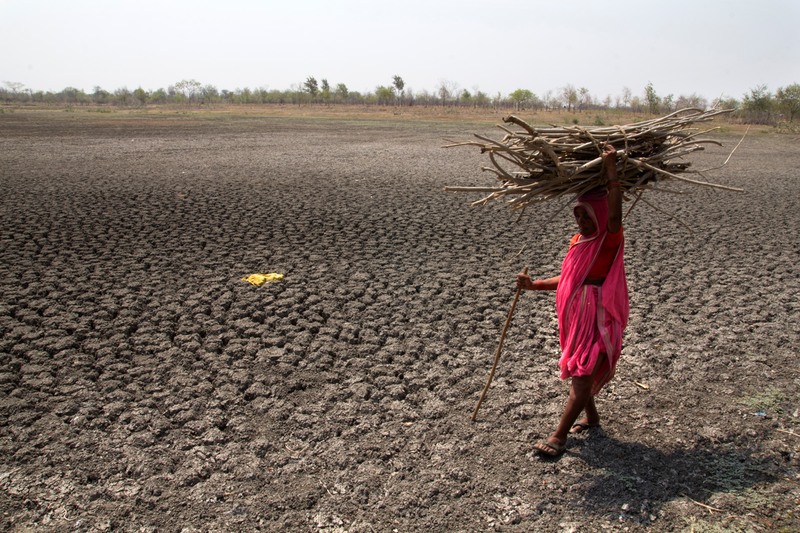India’s coal power plants are shutting down because they don’t have enough water

Despite the Indian government’s determination to double or even triple domestic coal production, the power sector is now being hit by water scarcity — with a new report warning the crisis could get far, far worse.
Just a couple of weeks ago the operators of the 2100 megawatt (MW) coal-fired Farakka power station in West Bengal shut down five of the six turbines due to lack of water.
A few days later the 500 MW sixth unit was shut down as well.
There wasn’t even enough water to supply the taps for workers at the plant or the adjoining township.
With the plant supplying five states, power network operators scrambled to cover demand.
It is currently estimated there won’t be sufficient water to allow the plant to run until at least March 25 — 13 days after the first units went offline.
READ MORE
Investigation: Coal plants risk global water shortage
How coal is pushing China’s water supplies to the limit
India has a growing coal glut
The 1720 MW Raichur Thermal Power Station in Karnataka state has been hit by lack of water too. Since March 15 it has had to shut down several of its units indefinitely.
With the power station shut down the plant operators are now running out of space to stockpile coal, more of which arrives by the day.
India’s water crisis
The problem is far larger than just the shutdowns of the Farakka and the Raichur plants: India is in the grip of a growing water crisis.
As of March 17 the Central Water Commission calculated water in 91 major reservoirs across the country was down to just 27% of total storage capacity.
This represents more than one-quarter less than the average over the last decade.
With the monsoon not due until June, the next few months could be very lean times for coal, hydro and gas power generators reliant on large volumes of water for boilers, cooling and to run turbines.
Water for power plants will either come at the expense of water for drinking, agriculture and other industries, or the power sector will be forced to do with less (or even without) in times of low-flows.
While the lack of water for the Farakka power station is caused in part by the requirement under the 1996 Farakka Water Treaty to share water with neighbouring Bangladesh, the phenomenon of coal power plants being shut down due to lack of water is not new.
One coal power plant has been closed for 9 months
The 1130 MW Parli power station in Maharashtra state has been shut down since July 2015 due to lack of water.
Five years earlier Maharashtra’s state-owned utility, MahaGenco, had shut down several units of the 2340 MW Chandrapur Thermal Power Station due to the impact of drought.
The construction of NTPC’s Solapur power plant in Maharashtra has been delayed due to huge question marks about where the plant will get water to run on.
Water scarcity could severely undermine the plant’s financial viability.

Coal and water: It’s a global problem
A new Greenpeace report notes if the Indian government continues to push the construction of more coal plants, the water crisis will grow significantly worse.
The report estimates over 170GW of coal power plants, representing 40% of the proposed Indian coal fleet, are in areas that are facing high or extremely high water stress.
While dry-cooled power stations are technically feasible, they are more expensive, consume more coal and still require water for steam-raising to spin the turbines.
The current water crunch for some coal plants has been flagged for years by civil society groups.
In its August 2011 report Thermal Power Plants on The Anvil: Implications And Need For Rationalisation the Prayas Energy Group foreshadowed the construction of ever more water-cooled coal-fired power stations would cause “immense stress” on water resources in the areas immediately adjoining plants.
They also cautioned that, due to variations in annual rainfall, there was no guarantee year-round water would be available for power stations.
What it means for renewables
With the Modi Government focused on increasing generation from currently under-utilised plants by increasing coal supply and restructuring the finances of the near-bankrupt distribution utilities, little attention has been devoted to the looming water crisis.
The completion of more part-built coal plants is likely to increase conflict over increasingly scarce water, even as climate change makes the Indian monsoon increasingly erratic and unpredictable.
If the water crisis continues to deepen, it may be one more factor pushing the Indian Government to further accelerate its shift towards non-hydro renewables.
This is an edited version of a blog published on EndCoal
Bob Burton is Editor of CoalWire, a weekly bulletin on global coal industry developments. (You can sign up for it here.) His Twitter feed is here.
Ashish Fernandes is a Senior Campaigner at Greenpeace. His Twitter feed is here.

